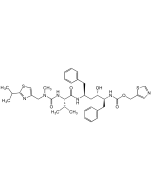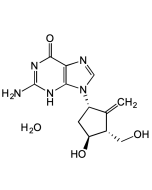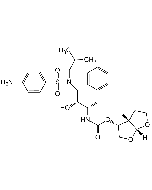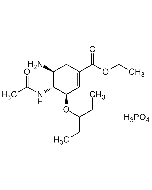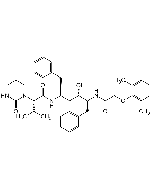Cookie Policy: This site uses cookies to improve your experience. You can find out more about our use of cookies in our Privacy Policy. By continuing to browse this site you agree to our use of cookies.
AdipoGen Life Sciences
Chloroquine . diphosphate
As low as
22
CHF
CHF 22.00
In stock
Only %1 left
AG-CR1-3721-G0011 gCHF 22.00
AG-CR1-3721-G0055 gCHF 55.00
AG-CR1-3721-G02525 gCHF 85.00
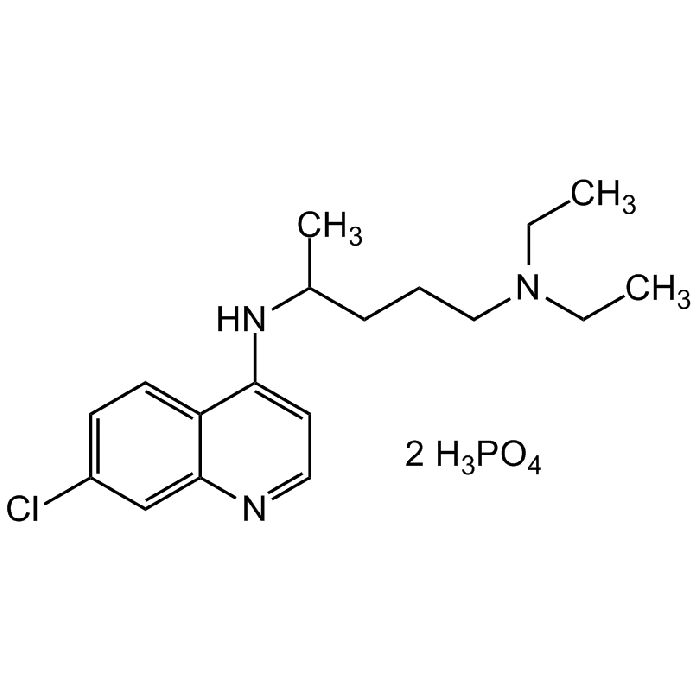
| Product Details | |
|---|---|
| Synonyms | N4-(7-Chloro-4-quinolinyl)-N1,N1-diethyl-1,4-pentanediamine diphosphate; DL-Chloroquine; NSC 14050 |
| Product Type | Chemical |
| Properties | |
| Formula |
C18H26ClN3 . 2H3PO4 |
| MW | 319.9 . 196.0 |
| CAS | 50-63-5 |
| RTECS | VB2450000 |
| Purity Chemicals | ≥98% |
| Appearance | White to off-white solid. |
| Solubility | Soluble in water (20mg/ml). |
| InChi Key | PDUDJJGBPNGGGN-UHFFFAOYSA-N |
| Smiles | ClC1=CC=C(C(NC(CCCN(CC)CC)C)=CC=N2)C2=C1.[2 H3PO4] |
| Shipping and Handling | |
| Shipping | AMBIENT |
| Short Term Storage | +4°C |
| Long Term Storage | -20°C |
| Handling Advice | Keep cool and dry. |
| Use/Stability | Stable for at least 2 years after receipt when stored at -20°C. |
| Documents | |
| MSDS |
 Download PDF Download PDF |
| Product Specification Sheet | |
| Datasheet |
 Download PDF Download PDF |
Description
- Chloroquine is a commonly used antimalarial drug, more toxic than its derivative hydroxychloroquine (Prod. No. AG-CR1-3720).
- Chloroquine has anti-inflammatory, immunomodulating, anti-infective, antiviral, antithrombotic and metabolic effects. It has anticancer properties, related to their strong antiproliferative, antimutagenic, epigenetic and autophagy inhibiting and apoptosis inducing activities.
- Chloroquine is used to treat rheumatoid arthritis, systemic lupus erythematosus, antiphospholipid antibody syndrome and Sjögren's syndrome. Chloroquine interfers with lysosomal activity and autophagy, interacts with membrane stability and alters signaling pathways and transcriptional activity, which can result in inhibition of cytokine production and modulation of certain co-stimulatory molecules.
- Chloroquine shows antiviral activity against several viruses by inhibiting viral replication and inhibits SARS-CoV-2 viral infection (COVID-19) in vitro.
Product References
- The anti-HIV-1 activity of chloroquine: A. Savarino, et al.; J. Clin. Virol. 20, 131 (2001) (Review)
- Antitumor and antimetastatic activities of chloroquine diphosphate in a murine model of breast cancer: P.D. Jiang, et al.; Biomed. Pharmacother. 64, 609 (2010)
- Chloroquine: modes of action of an undervalued drug: R. Thome, et al.; Immunol. Lett. 153, 50 (2013) (Review)
- The utility of chloroquine in cancer therapy: Y. Zhang, et al.; Curr. Med. Res. Opin. 31, 1009 (2015) (Review)
- Chloroquine and beyond: exploring anti-rheumatic drugs to reduce immune hyperactivation in HIV/AIDS: A. Savarino & I.L. Shytaj; Retrovirology 12, 51 (2015) (Review)
- Time to use a dose of Chloroquine as an adjuvant to anti-cancer chemotherapies: S. Pascolo; Eur. J. Pharmacol. 771, 139 (2016) (Review)
- Chloroquine could be used for the treatment of filoviral infections and other viral infections that emerge or emerged from viruses requiring an acidic pH for infectivity: H. Akpovwa; Cell Biochem. Funct. 34, 191 (2016) (Review)
- In vitro and in vivo antitumor effects of chloroquine on oral squamous cell carcinoma: L. Jia, et al.; Mol. Med. Rep. 16, 5779 (2017)
- Chloroquine inhibits autophagic flux by decreasing autophagosome-lysosome fusion: M. Mauthe, et al.; Autophagy 14, 1435 (2018)
- The clinical value of using chloroquine or hydroxychloroquine as autophagy inhibitors in the treatment of cancers: A systematic review and meta-analysis: R. Xu, et al.; Medicine 97, e12912 (2018) (Review)
- Current and Future Use of Chloroquine and Hydroxychloroquine in Infectious, Immune, Neoplastic, and Neurological Diseases: A Mini-Review: D. Plantone & T. Koudriavtseva; Clin. Drug Investig. 38, 653 (2018) (Review)
- Mechanisms of action of hydroxychloroquine and chloroquine: implications for rheumatology: E. Schrezenmeier & T. Dorner; Nat. Rev. Rheumatol. 16, 155 (2020) (Review)
- To consider or not antimalarials as a prophylactic intervention in the SARS-CoV-2 (Covid-19) pandemic: F.R. Spinelli, et al.; Ann. Rheum. Dis. (Epub ahead of print) (2020)
- New insights on the antiviral effects of chloroquine against coronavirus: what to expect for COVID-19? C.A. Devaux, et al.; Int. J. Antimicrob. Agents. (Epub ahead of print) (2020)







